Understanding lung diseases and optimizing their treatment

Understanding the distribution of nanoparticles after inhalation can lead to the discovery of novel, more effective drug delivering techniques. To this end we develop AI-based methods for semantic segmentation of the airways in non-dissected whole murine lungs, imaged with light sheet fluorescence microscopy. The analysis of airway properties in diseased lungs will furthermore shed light on the pathogenesis of common diseases such as COPD and may lead to novel therapeutic strategies.
Other Collaborations

Paving the way for future mineral processing and recycling technologies through large-scale analysis of particulate samples
Understanding and quantifying the exact composition of mineral samples paves the way towards advanced methodologies that not only increase the effectiveness of ore processing but also enable future recycling technologies. To this end, samples consisting of ground particles embedded into an epoxy matrix are imaged with computed tomography (CT) at micrometer resolution. Due to the […]
Ultra Content Screening for Clinical Diagnostics and Deep Phenotyping
For the Helmholtz Imaging project UCS (Ultra Content Screening for Clinical Diagnostics and Deep Phenotyping) we developed software to allow the project partners to process their immunofluorescence labelled light microscopy data of nuclei and cells for single cell proteomics. The developed pipeline includes instance segmentation of nuclei and cells in the immunofluorescence assays, registration of […]